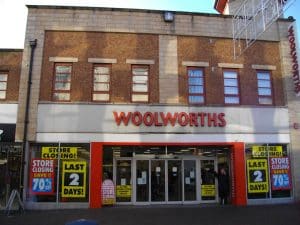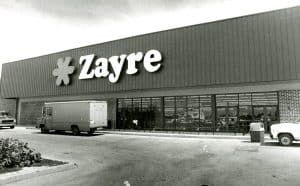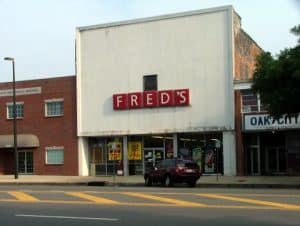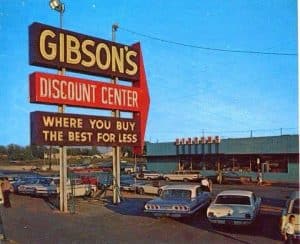
Sears, JCPenney, Belk: the many-sided face of the declining department stores in America you know, hanging on by a thread in dying malls or standing all alone like tombstones marking the rise of Walmart and Amazon Prime. The Mets will be around but department stores dying out is a long and hallowed tradition in this country. Yet these disappearing stores were staples of many people’s lives, either as their first job or the best hangout spots, or just nostalgic shopping destinations.
So today, we’re looking at 10 of the biggest department stores ever that most of you grew up with that have all gone the way of the dodo. Let’s walk through the front door of Nostalgia Central and peruse the aisles for sweet memories.
Woolworths

We begin with the granddaddy of them all, the original five and dime, the most nostalgic store, F.W. Woolworth Company. Founded in 1879 in Lancaster, Pennsylvania Woolworth’s pioneered practices that we take for granted today. The store was on the forefront of directly advertising certain products to consumers, aka merchandising.
RELATED: There Is Only One Vintage Woolworth Luncheonette Left In America
Woolworths had a lunch counter in the store, a predecessor to today’s food courts and most importantly was one of the first shops in the nation to employ direct purchasing, in which a customer finds an item on the shelves themselves rather than having to rely on a shopkeeper to go and find it. The public loved these innovations and by 1913 there were almost 600 Woolworth locations nationwide, including the newly opened Woolworth Building, the corporate headquarters of the chain located in Manhattan. Did you know that was the tallest building in the country from 1913 until 1930? Believe it or not, it is still in the top 100 today!
Jump forward to 1979 and Woolworths was the largest department store chain in the world. But all good things must come to an end and every U.S location was closed by 1997. The company decided to focus on its sportswear line and renamed itself Foot Locker. In this way, it is still alive and well so if you’re in need of some nostalgia head to your nearest mall, head into that sports store, pull on a pair of Nikes and think about past glories there.
Zayre

What do you do when you flee Russia and the Tsar’s draconian conscription polices during World War I for the freedom-loving shores of America? Brothers Max and Morris Feldberg founded a chain of department stores. Of course, the two knew they wanted to start a store but they were struggling to come up with a good enough name. Eventually, they leaned into their Jewish heritage and used the Yiddish phrase Zer, meaning “very good.” Zayre was indeed very good and with famous gimmicks like the flashing light 15-minute sale meant to direct people to certain parts of the store, the chain grew to be the fifth-largest discount retailer in the country.
The gravy train did not last forever and in 1988, the chain was sold to rival Ames. By 1990, every Zayre had been closed but don’t feel too bad; in the 1980s Zayre tried to buy Marshalls. It failed but created a little-known clone called TJ Maxx, which of course did fantastically, eventually even buying Marshalls – which is super funny – thereby ensuring the Feldberg brothers’ legacies would continue
Ames

But what about this Ames chain that was so ruthlessly bought out? What if I told you that at one point Ames was the fourth-biggest retail store in America? Yup, in the late 90s, it went: Walmart, Kmart, Target, and Ames number four. It was founded in 1958 in Massachusetts. Ames rose to prominence by locating their stores mainly in rural areas, which didn’t have much competition, thereby dominating the markets that they did enter. But why isn’t Ames still ubiquitous?
Well, in 1990, they declared bankruptcy for two reasons. First of all, they had a habit of extending credit to just about anyone – no background check required, so they lost a ton of money when people stopped paying their bills. Secondly, they bought Zayre, which saddled them with so much debt that the whole chain went under. Big mistake. But never fear – Ames survived and emerged better than ever until they bought rival Hills in 1998, so they got some more debt the same result and by 2002 the company was in bankruptcy again and closed for good.
Hills
Hills was once the Giant Slayer that crushed the once almighty Ames after being swallowed whole at one point. Hills was the eighth-largest retailer in the U.S., hardly impressive at this point. Hills was founded in Ohio in 1957. Originally a full-fledged department store, the chain quickly pivoted into the discount market and… Hills may be a nostalgic store but its story isn’t terribly thrilling – they came, they saw, they got bought out. It feels like even the name is false advertising because surely not every store was on a hill!
One cool thing though is kids really like their Easter egg hunts and their pumpkin hunts, which makes sense because they were all on a hill.
J. J. Newberry

J. J. Newberry was founded in Pennsylvania in 1911 as a five and dime clone of Woolworths. People apparently really liked five and dimes back then and just like its direct competitor, Newberry became exceedingly popular, numbering over 500 stores in 1961. The chain was sold to rival McCrory’s – more on them later – that was in 1972 and unlike other acquisitions on this list, the purchase actually went very well and for two decades Newberry flourished.
Then the ’90s and Walmart came calling and things went south. In 1997, 300 Newberry stores were closed and in 2000 the remaining stores were converted to Dollar Zones because at the turn of the millennium, everything had to sound like you could ride a skateboard through it this obviously did not work and the brand was effectively defunct by 2002.
Fred’s

Founded in Coldwater, Mississippi in 1947, Fred’s became a success by focusing on rural areas; most locations were in towns with less than 15,000 people, which guaranteed Freed’s would be a nostalgic store for that population. Fred’s main competitors in these towns were Dollar General, Family Dollar, and Dollar Tree. It seems like Fred’s isn’t even trying – couldn’t they have been Fred’s Dollar or at least Dollar Fred’s? Maybe they should have been, because the last just plain Fred’s closed in 2019, while as we know, those Dollar franchises are still going dollar strong.
Gibsons Discount Center

Gibson’s Discount Center was founded in Abilene, Texas in 1960 and grew extraordinarily fast by relying on the franchise model of operation rather than having one big corporate entity. Sam Walton even inquired about owning a franchise at one point but nothing came of that exciting opportunity for him.
GDC, as it shall hereafter be known, reached a high point of 684 stores in 1978, but fortunately for old Sam, it seems like he made the right choice as the chain fell victim to the ’90s. Almost every location was gone by 2002.
But if you have an itch that only GDC can scratch, there are still two in Texas and two in Kansas, so on a 15-hour road trip you can hit every one of them, baby!
McCrory Stores
McCrory Stores was founded in Pennsylvania in 1882 by John Graham McCrory, a man so notoriously cheap that he legally had the E removed from his last name so he wouldn’t have to pay for the extra letter on the store sign. Oh, he has a place in my heart but it was all uphill from there and despite a bankruptcy during the Great Depression, McCrory was once the fourth-largest retailer in the country with over 1300 stores at its height.
However, the thriftiness failed to continue and McCrory succumbed to the ’90s plague that hit all these nostalgic department stores and ceased operation in 2002.
Those were the 10 biggest department stores you most certainly grew up with that aren’t around today. So honestly, how many of these have you been to? Is there one that we forgot about and which was your personal favorite? Get in the comments and let us know we love reading your thoughts!

